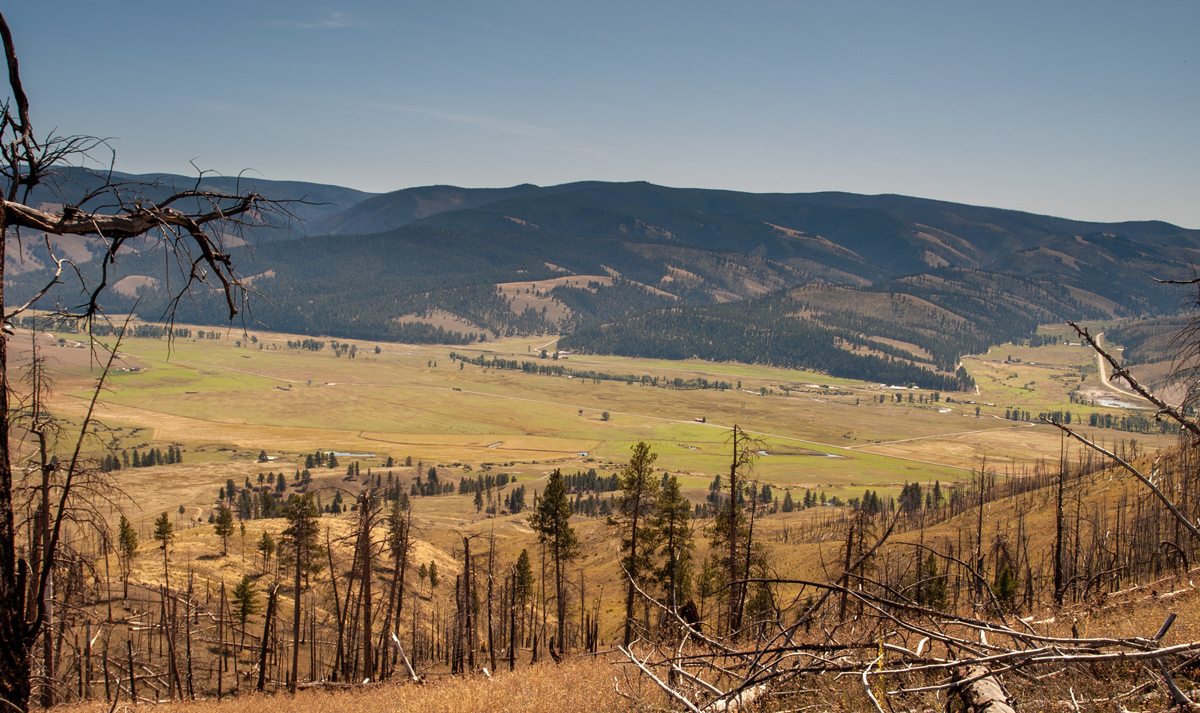After a cold, wet, and hungry night atop the Lost Trail divide, the men thaw their frozen sailcloth, wrap the packs, and load the horses. They then descend to present Ross’ Hole where Flathead Salish People provide a warm welcome.
“Lewis and Clark Meeting the Flatheads in Ross Hole, 4 September 1805”
Reproduced by permission of the Montana Historical Society.
Meeting the Salish
prosued our Course down the Creek to the forks about 5 miles where we met a part of the
Flat headnation of 33 Lodges about 80 men 400 Total and at least 500 horses, those people recved us friendly, threw white robes over our Sholders & Smoked in the pipes of peace
—William Clark
Welsh Indian Myth
they have the most curious language of any we have Seen before. they talk as though they lisped or have a bur on their tongue. we Suppose that they are the welch Indians if their is any Such from the language.
—John Ordwaythey Stout & light complected more So than Common for Indians
—William Clark
Ross’ Hole from Sula Peak
© 9 September 2009 by Kristopher K. Townsend. Permission to use granted under the Creative Commons Attribution-Share Alike 4.0 International license.
The expedition traveled down to Camp Creek, the small valley on the extreme right in the above photograph. On 6 September 1805, the expedition would cross Ross’ Hole and then, climb up the ridge towards the camera.
Thawing Out
the morning clear, but very cold. the ground covred with frost. our mockasons froze. the mountains covred with Snow . . . . we delayed untill about 8 oClock A. M. then thoughed [thawed] our Sailes by the fire to cover the loads and Set out. ascended the mountain on to the dividing ridge and followed it Some time. the Snow over our mockasons in places. we had nothing but a little pearched corn to eat the air on the mountains verry chilley and cold. our fingers aked with the cold
—John Ordway
Descent to Ross’ Hole
we assended a mountain & took a Divideing ridge which we kept for Several Miles & fell on the head of a Creek which appeared to run the Course we wished to go, I was in front, & Saw Several of the Argalia or Ibex [bighorn sheep]
—William Clark
Dining on Deer
our hunter killed a deer on which we dined. our guide [Toby] and the young Indian who accompanied him eat the verry guts of the deer.
—John Ordway
Weather Diary
State of the Thermometer at rise
Weather at rise
Wind at rise
State of the Thermometer at 4 P.M. Weather at 4 P.M. Wind at 4 P.M. 19 [above 0] rain after snow N E 34 [above 0] cloudy after rain N E ice one inch thick.
—Meriwether Lewis[1]To assist the reader, the editor of this web page has omitted the date column and spelled out some abbreviations.
Ross Hole is a High Potential Historic Site along the Lewis and Clark National Historic Trail managed by the U.S. National Park Service. On US Highway 93, at the Sula Country Store, a road-side pull-off provides views of the valley and interpretive signs.
Notes
| ↑1 | To assist the reader, the editor of this web page has omitted the date column and spelled out some abbreviations. |
|---|
Experience the Lewis and Clark Trail
The Lewis and Clark Trail Experience—our sister site at lewisandclark.travel—connects the world to people and places on the Lewis and Clark Trail.
Discover More
- The Lewis and Clark Expedition: Day by Day by Gary E. Moulton (University of Nebraska Press, 2018). The story in prose, 14 May 1804–23 September 1806.
- The Lewis and Clark Journals: An American Epic of Discovery (abridged) by Gary E. Moulton (University of Nebraska Press, 2003). Selected journal excerpts, 14 May 1804–23 September 1806.
- The Lewis and Clark Journals. by Gary E. Moulton (University of Nebraska Press, 1983–2001). The complete story in 13 volumes.





